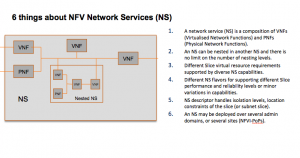As one of the hallmarks of soon-to-launch 5G, network slicing has the potential to revolutionise the services mobile operators offer to their customers. And as also recognised by the majority of industry stakeholders (standards organisations among them), virtualised networks are expected to play a key role in realising network slicing as both lay on the concept of creating and delivering logical networks.
It is with this in mind that network slicing is a key part of the framework and standards currently being created by ETSI NFV. As part of this, ETSI NFV has identified use cases related to network slicing, looking at how NFV will need to be adapted to utilise network capacity efficiently, says Tetsuya Nakamura.
But there are hurdles to be overcome, not least around the definition of network slicing. Currently, there is no single definition of network slicing widely agreed: different standards organisations have contrasting views on what the concept means.
Indeed, network slicing is difficult to define because it is not just a function: the technology is contextual depending on the service being provided.
Network services and network slicing
Network Slicing offers a vast array of capabilities, but how does it work? According to 3GPP TR 28.801, a network slice contains one or more subnets. Each of these contains network functions – and they can also incorporate other network slice subnets.
According to ONF TR-526, slicing requires the partitioning and assignment of a set of resources that can be used in an isolated, disjunctive or shared manner. A set of such dedicated resources is known as a network slice instance (NSI).
But, how does network slicing relate to NFV and in particular to the NFV architectural framework? One use case derived from 3GPP TR 28.801 is when the operator decides to create a new NSI. In this case, the network function contained in the NSI can be either a virtualised network function (VNF) or a physical network function (PNF) – and the VNF’s resources are managed by the NFV-MANO system. But how are network level resources managed by the NFV-MANO system? The answer is the Network Service (NS).
The Network Service concept specified by ETSI NFV fulfils the need of network operators to consolidate the resource requirements and their orchestration in order to deploy and maintain a network. A Network Service is a composition of Network Functions (NF) arranged with or without specified connectivity and topology. NFs can be incorporated into an NS as VNFs and PNFs. Furthermore, a Network Service can be built in a modular manner, then combined in other composite Network Services.
As an example, the quality of service and availability requirements for resources supporting a network slice can be dealt with by including appropriate information in the Network Service Descriptor (NSD) – and the corresponding virtual network function descriptor (VNFD) – as well as by selecting appropriate deployment flavours at the time of instantiation.
Resource sharing and other issues
There are a number of key issues that need to be further elaborated to realise network slicing. First, it is clear that network slicing is all about resource sharing. However, prioritisation is important: it needs to be assessed how to allocate a service to each given customer. It is true that resources can be shared across network slices, but keeping a certain level of availability – and across customers – is key.
Secondly, it is also integral that security and reliability in network slicing are well considered from the very beginning. In terms of security, the allocated resources during network slice instance creation and the network slice management operations should be isolated. Particular attention could be needed where a network slice is used by a certain industry, such as public safety.

Meanwhile, from a reliability point of view it is important to take into account run-time operations. This includes maintaining the assigned resources to fulfil the availability and reliability requirements during the NSI lifecycle whenever anomalies occur.
Taking the above into account, is NFV ready for network slicing? On the whole, we could answer that “yes.” Most features required to enable network slicing are already incorporated in the ETSI NFV architectural framework.
In this regard, ETSI NFV’s recommendations delivered by the published study item have determined the potential requirements to enhance the lifecycle management of Network Services used as part of a network slice or slice subnet.
A few examples of the type of potential requirements derived are:
- Policy handling requirements for Network Service instances such as prioritisation, and ascertaining the demands for performance and fault data handling.
- Security related requirements to ensure the right levels of resource isolation and allocation policy at NFV infrastructure, Network Service, and VNF levels.
- Reliability related requirements to ensure if a network service instantiation is used in the creation of a NSI, or network slice subnet instance. It is also essential that the reliability of a network slice instance is maintained when it is being terminated, or after resource changes.
So, it is clear that network slicing is an important consideration as ETSI NFV works on creating the framework and standards related to NFV. It is now essential to agree definitions around what the capability is and how it can be deployed.
The author of this blog is Tetsuya Nakamura of CableLabs, vice chairman of the ETSI NFV group
Comment on this article below or via Twitter: @VanillaPlus OR @jcvplus






